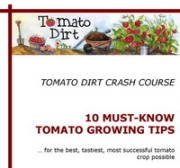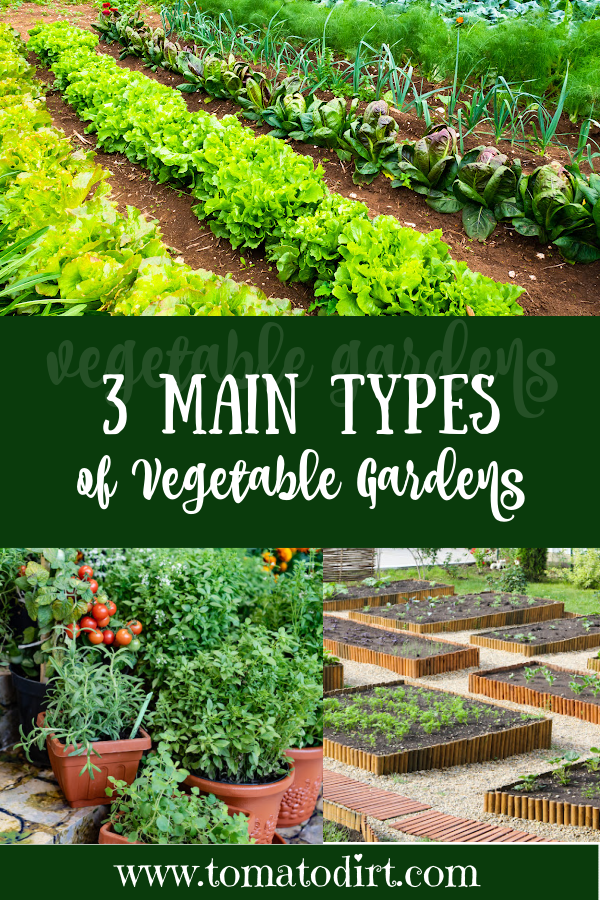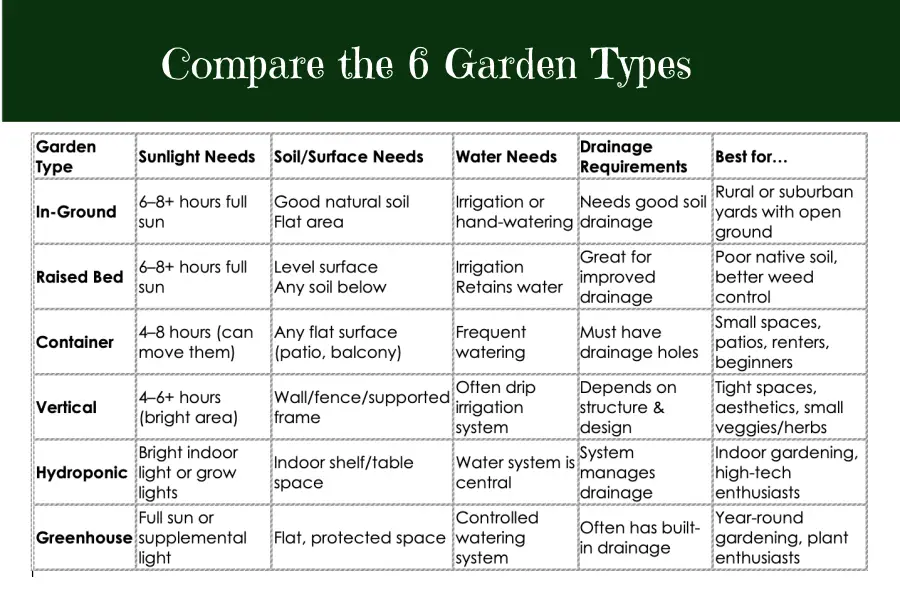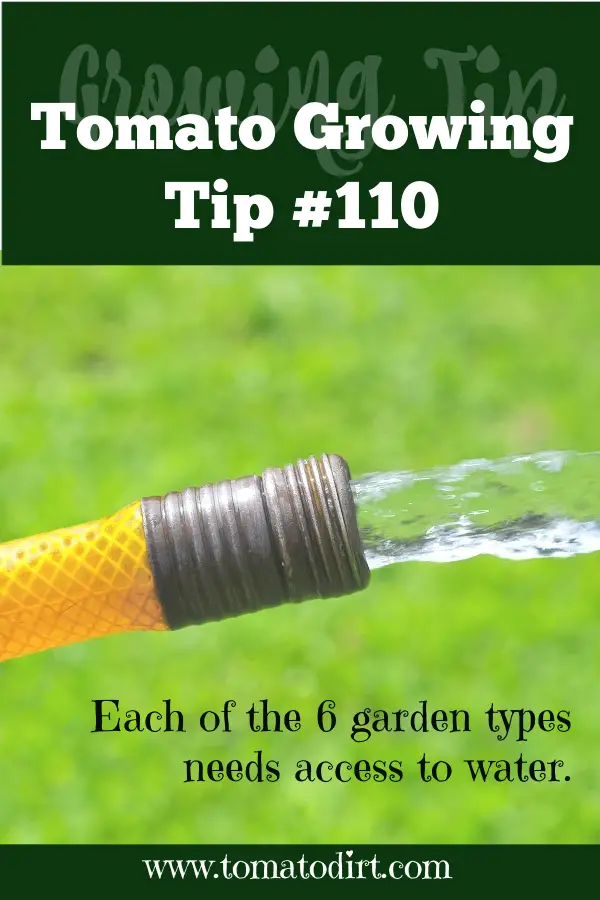FREE: 10 Must-Know Tomato Growing Tips Get The Guide
Read our affiliate disclosure here.
What Type of Vegetable Garden Is Best For You?
Since 2010, Tomato Dirt has garnered 4.8+ million views, making it the web’s leading online source for growing tomatoes in the home garden. Award-winning writer and Tomato Dirt owner Kathy Widenhouse has helped thousands of home gardeners grow healthier tomatoes. Be one of them when you get Tomato Dirt’s Growing Guide here.
Posted 4.14.25
What type of vegetable garden is best for you …and for growing tomatoes?
Seems like a silly question. After all, to grow a vegetable garden all you need to do is to dig up some dirt, throw in a few seeds and seedlings, keep it watered, and BOOM! You’ve got produce – right?
Oh, if only that was the case.
As you choose the type of vegetable garden for your situation, you have a few things to consider: how much space you have (or don’t have) … how much time you have (or don’t have) … how much money you want to spend (or not spend) – not mention considerations like exposure, and climate.
Use this simple tutorial to help you understand the types of vegetable gardens you can grow as well as special considerations for each.
The 3 main types of vegetable gardens
There are three main types of vegetable gardens for the home gardener.
1. In-ground gardens
In an in-ground garden – the most traditional garden type – vegetables and tomatoes are planted directly into the native soil of your yard or property. An in-ground garden doesn’t require building structures or containers. All you need is a prepared patch of land, some tools, and good gardening practices.
One advantage of an in-ground garden is that it is budget-friendly. It can be as small or large as space and time allow. A good starter size for a vegetable garden is 50-75 square feet.
In terms of growing tomatoes and other vegetables, an in-ground garden allows plants to develop deep root systems. The soil – along with worms and microbes – support root health and healthy nutrition. And as you work and rework organic matter into the soil year after year, your growing environment improves.
True, an in-ground garden may require you to amend poor soil … battle weeds … clash with pests and insects … and grapple with rain and drought. Gardeners have faced these challenges for millennia.
Special considerations for growing tomatoes in in-ground gardens
- Soil prep is key: Tomatoes thrive in loose, rich, well-drained soil with plenty of organic matter.
- Test your soil: Check pH (ideal: 6.0–6.8) and the soil’s nutrient levels before planting.
- Crop rotation matters: Don’t plant tomatoes in the same spot every year. Rotate your crops to avoid disease buildup and nutrient leaching n the soil.
- Mulch well: Straw, wood chips, or compost can help suppress weeds, conserve moisture, and prevent soil splash (which can spread disease).
- Stake or cage: Tomatoes still need support even in the ground to keep fruits off the soil and promote airflow.
2. Raised bed gardens
A raised bed garden is a growing space where soil is contained above ground level, usually within a framed box made of wood, metal, stone, or plastic, which “raises” them above the soil surface. These beds are filled with improved soil, allowing you to control growing conditions more precisely.
Raised beds are a favorite among tomato gardeners because they are easier to manage than full in-ground gardens. You can fill beds with nutrient-rich, well-drained soil tailored for tomatoes. Excess water drains faster. There are fewer weeds to pull, which means less bending and kneeling. The bed’s elevation above ground level reduces the number of pests who invade your tomato crop. And since you don’t walk on the soil in between rows, it doesn’t compact as much which allows tomatoes to spread their root systems easily.
Raised bed gardens have some disadvantages, too. They can be expensive to set up because you must pay for the beds themselves plus the fill dirt. And since the beds drain well, you must keep tomato plants watered and fertilized during the heat.
Special considerations for growing tomatoes in raised beds
- Bed depth matters: Tomatoes grow best in beds that are at least 12 inches deep, preferably 18–24 inches.
- Spacing is key: Allow 18–24 inches between plants for airflow and sunlight, even in raised beds.
- Choose the right soil: Use a blend of topsoil, compost, and organic matter (try a Mel's Mix or vegetable mix).
- Mulch well: This helps retain moisture and reduce temperature swings.
- Water regularly: Raised beds can dry out more quickly, especially in summer or windy areas.
3. Container gardens
Container gardens provide a home for vegetable plants in pots or containers rather than directly in the ground. They are ideal for small spaces, balconies, and patios.
Gardens in containers are versatile, making them ideal for urban settings or small yards where space for a traditional garden is limited. You can use specific soil mixes tailored to the needs of tomatoes or other vegetables, which can increase your yield. Plus, you can move containers easily to give plants the best sunlight exposure and to protect them from windy or extreme conditions.
But be aware that in containers, plants can become root-bound more quickly – a good reason to use as big of containers as possible. You’ll need to water and fertilize container gardens more often than in-ground gardens, particularly in hot weather, because nutrients leach away easily and soil dries out much faster than in in-ground gardens.
Special considerations for growing tomatoes in containers
- Tomatoes need room to grow—especially their roots. Use at least a 5-gallon container for determinate (bush) varieties, and 10 gallons or more for indeterminate (vining) varieties.
- Plastic retains moisture better; clay breathes better but dries out faster.
- Make sure your container has drainage holes to prevent root rot.
In addition to the 3 most universal types of vegetable gardens, you may consider other less common options.
Vertical gardens
A vertical garden is a space-saving gardening method where plants are grown upward on structures such as walls, trellises, shelves, hanging pockets, towers, or modular panels—rather than outward across the ground.
They're perfect for small spaces like balconies, patios, or tiny yards because they maximize space. Plus, upright growth means your plants receive better light. Tomatoes, in particular, are less susceptible to diseases in vertical gardens because they have better air circulation.
Special considerations for growing tomatoes in vertical gardens
- Best tomato types: Choose dwarf, compact bush (determinate), or cherry tomato varieties.
- Support is key: Use strong vertical frames or cages to support plant weight as tomatoes grow.
- Container depth: Each plant needs at least 12–18 inches of soil depth for healthy roots.
- Water consistently: Uneven watering can lead to issues like blossom end rot.
Hydroponic gardens
A hydroponic garden is a method of growing plants without soil, using a nutrient-rich water solution instead. Instead of drawing nutrients from soil, plants grow in a controlled environment—often supported by inert mediums like coco coir, perlite, rockwool, or clay pellets—and receive everything they need from the water.
Hydroponic systems can be as simple as a DIY container on a windowsill or as complex as a multi-tiered, fully automated system with timers, pumps, and grow lights. They are traditionally maintained indoors.
The advantage to growing vegetables and tomatoes hydroponically is efficiency. Plants grow 30-50% faster than in-ground vegetables because they have direct access to nutrients. Plus, stackable or vertical systems use very little floor space.
On the downside, hydroponic growing systems incur a significant start up cost. Most beginners find the learning curve more complex than traditional gardening.
Special considerations for growing tomatoes in hydroponic gardens
- Choose the right variety: Go for dwarf, bush, or indeterminate cherry tomato types like Tiny Tim, Bush Goliath, or Red Robin.
- Support is essential: Use trellises or clips to support vining growth.
- Lighting: Tomatoes need 12–16 hours of light daily—supplement with LED grow lights indoors.
- Pollination: Indoors, tomatoes need manual pollination (shake the plant, use a soft brush, or turn on a fan).
- System types: Tomatoes do well in drip systems, deep water culture (DWC), or Dutch buckets.
Greenhouse gardens
A greenhouse garden is an enclosed growing environment, usually made of glass or clear plastic, that allows gardeners to control temperature, humidity, and light for growing plants. Greenhouses range from simple backyard structures to large commercial units and can be used year-round, depending on climate and design.
A greenhouse garden lets you grow tomatoes – or any other crop, for that matter – year round. Your plants can have consistent temperatures and humidity. They’re protected from frost, wind, heavy rain, and extreme heat.
However, building or buying a greenhouse can be expensive. Your structure must have good ventilation, or it will get too hot and stress your tomato plants. And you’ll need to manually pollinate blossoms.
Special considerations for growing tomatoes in greenhouses
- Best varieties: Choose indeterminate tomatoes for long seasons, like Sungold, Early Girl, or Beefsteak.
- Support system: Use trellises, strings, or stakes to manage tall vine growth.
- Airflow is crucial: Tomatoes in greenhouses are prone to fungal issues—use oscillating fans to keep air moving.
- Temperature sweet spot: Ideal tomato fruiting temps are 70–85°F (21–29°C) during the day and 55–70°F (13–21°C) at night.
- Fertilization: Monitor nutrient levels closely, especially in soil-less or container systems.
Image courtesy of Tomato Dirt
What to consider when choosing a type of vegetable garden for your situation
Space, sunlight, drainage, and access: each of the different types of gardens have unique demands. For instance, container gardens flourish on patios, balconies, or rooftops, where traditional in-ground gardens wouldn’t work. Meanwhile, in-ground gardens require good soil and flat space. And raised beds need a level surface but can be placed over poor soil.
Now that you’ve got an overview of garden types, be sure to consider the following factors.
Each type of vegetable garden has different sunlight needs
- If you choose containers, you can move them around for optimal light.
- If you go with a permanent raised bed, it needs to be placed in a spot that already receives 6–8 hours of direct sun daily.
- Hydroponic gardens need artificial light to supplement natural light.
Each type of vegetable garden requires different water access and drainage
- Raised beds and in-ground gardens benefit from natural drainage, while container gardens need more frequent watering and good drainage holes.
- A vertical garden may need to be near a wall and set up with a drip irrigation system.
- In-ground gardens should avoid low-lying areas where water pools.
Each type of vegetable garden requires different maintenance
Some gardens are more labor-intensive than others. If you're choosing a low-maintenance container garden, you might set it near your back door for convenience. A large in-ground plot, however, will need a bigger, more open space and consistent weeding to produce its best crop.
Be sure to consider …
- How far it can be from your water source
- How often you'll need to check it
- Whether you'll need tools like shovels, trowels, or trellises
Other special considerations for choosing what type of vegetable garden to grow
- Do you have windy areas? Avoid exposed spots for in-ground or raised beds; containers can be moved or shielded.
- Do you have a shady yard? Vertical or container gardens allow you to follow the sun or place grow lights indoors.
- Do you have limited mobility? Raised beds and containers at waist height make access easier.
Every type of vegetable garden is “best” – depending on
your circumstances.
Urban vs. rural, hilly vs. flat, sandy vs. clay, rolling farmland vs. apartment dwelling —your environment plays an important role in choosing the garden type that’s best for you.
And while your natural circumstances are a key factor in choosing the type of vegetable garden to grow, don’t neglect the most important factor: you. Which type of vegetable garden will give you most pleasure and be reasonable to maintain?
Answer that question honestly … and you can start digging and planting.
More on Starting a Vegetable Garden
How To Start a Vegetable Garden: 10 Tips For Beginner Gardeners ...
How to pick the best home garden spot for growing tomatoes ...
How to plan a garden layout for growing vegetables and tomatoes ...
7 Very Cheap Garden Fence Ideas ...
Spring Garden Clean Up: Get Your Garden Ready for the Season...
18 Tips for Planning a Vegetable Garden (Even If It’s Winter) ...
Garden layout ideas on our Pinterest board ...
Return from What Type of Vegetable Garden Is Best for You?
to Tomato Dirt home
As an Amazon Associate and Rakuten Advertising affiliate I earn from qualifying purchases.
SHARE THIS PAGE:
FREE! 10 Must-Know Tomato Growing Tips: 20-page guide
Get yours here:







